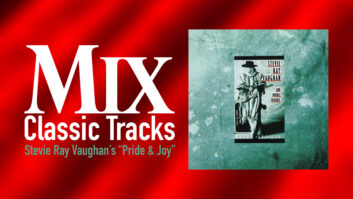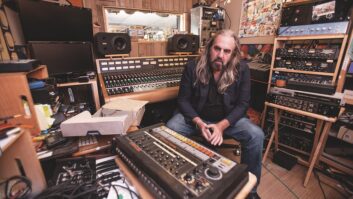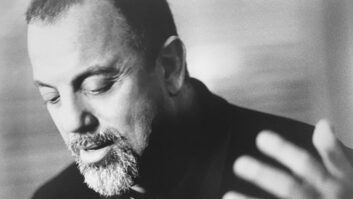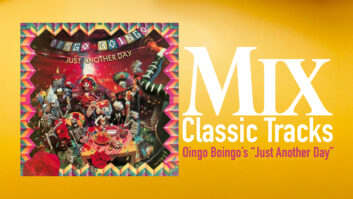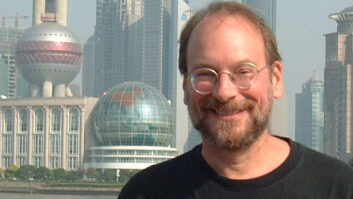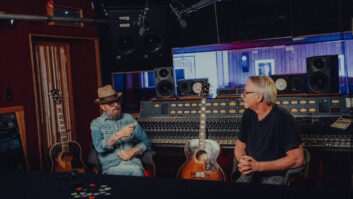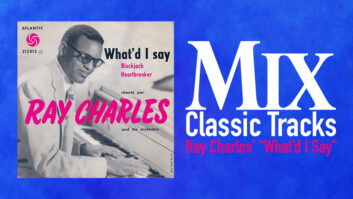
Dolly Parton is a master storyteller, an unabashed force of feel-good who’s penned a half-century of hits. Now, those timeless narratives get the visual treatment in Dolly Parton’s Heartstrings.

The Netflix series, produced in association with Warner Brothers Television, brings the stories behind Parton’s most beloved songs to life in eight episodes, each featuring different characters, settings, and time periods.
It’s big hearted, star studded, and always about the music. And that music has been given star treatment, with an A-list cast showing off their singing talents and Parton re-recording classic songs and contributing vocals to a sweeping score performed by the LA Philharmonic.
Because each episode tells a unique story, each show called for a unique approach to layering dialog, music, and effects. Monkeyland Audio’s Re-Recording Mixer James Parnell (PEN15, Trinkets, K-12, Perfect Date) talks about the challenges and rewards of bringing a living legend’s songs to life on the small screen.
You work on both film and television. What’s your project mix?
With the streaming services, it kind of leans more toward television, maybe 60/40 television. The typical cycle of post production has changed dramatically since streaming services began. Instead of having this lull in the new year before pilot season ramps up again, we’re constantly busy and taking new projects now. I’m working on a feature film going to Tribeca, and I’m supervising season two of Trinkets. I also just finished mixing a series for a new streaming service, Quibi.
With bigger-budget shows like Heartstrings, do you get more time with material?
Post-production sound mixing, especially network television mixing, has traditionally been fast-paced. Obviously, some schedules can be a little bit faster than others. For Heartstrings we had two days of mixing and a day for client playback, per episode, which was great.
Our supervising sound editor Trip Brock would visit Warner Brothers and sit with their picture editorial staff for spotting sessions; this would give our team the ability to discuss the sonic ideas we would need to shape for the show. During the spotting sessions, we would be listening to the editors rough sound mix.
Our composers, Mark Leggett and Ray Bunch, did a fantastic job, composing all of the music. After recording their music with the help of the LA Philharmonic Orchestra at Capitol Studios, they then integrated that score with Dolly Parton’s original music and material that she was re-recording specifically for Heartstrings.
https://youtu.be/Rk0dfTAH7ME
How do you approach mixing a music-driven drama? Were there challenges in maintaining each song’s impact across an hourlong format?
We got a good idea right off the bat that yes, this series was different. Whereas traditionally you would approach a TV show mix by mixing the dialog first, for Heartstrings, the story was driven by the songs, and it was Dolly’s creative intention to have her songs tell the stories themselves.

Obviously, there are still traditional dramatic scenes with actors talking. But a lot of the impact comes from the music. We definitely had to approach the mix process differently. Every song opened with a musical number or some sort of adaptation of her song. Then we would get into the stories themselves.
Often my mix partner, Kelly Vandever, and I would sit down on the first day and say, “Okay. Today we’re mixing ‘Crackerjack.’” We’d jump into the middle of the show and just hit Play and listen to the songs, and get a feel for the story. We’d then be able to say, “This is how we’re going to approach the mix.”
So the songs provide a dramatic framework, and a sonic framework. At the same time, each episode stands alone. Is there an overarching aesthetic?
It was the music that gave all of the shows a common theme. Regardless of the genre, regardless of the story you’re telling, Dolly’s music was approaching each story from a place of love and compassion and understanding. All of the episodes dealt with different subject matter, but they were all bridged by Dolly’s voice and music.
Another common aesthetic was the detailed sound editorial. We had a fantastic team of sound effects editors, Ray Park and Joshua Fernberg; they did a phenomenal job of designing the sounds for the worlds in which these characters live. Some standout moments for detailed sound effects work were the trading-post gun battle scene in JJ Sneed or the subtlety of the quiet lake scene in Sugar Hill. The approach to music mixing also helped sew the episodes together. During transitional moments or score-forward moments, we would really lean into the wonderful music that we were given by the LA Philharmonic, to transition our characters from one scene to the next.
Were her original songs all re-recorded for the show?
A lot of the songs had to be re-recorded or customized because the original timing, tempo, and pitch didn’t mesh with the pacing of the episodes. Dolly did an amazing job of doing that.

These songs are so iconic. Were you trying to preserve their original aesthetic?
Yes, our aim was to be as faithful to Dolly’s songs as possible. The goal was to kind of replicate and elaborate. It was to take these iconic songs and creatively make them serve the story that the directors and the producers are trying to tell but also not stray too far from the original goal that Dolly had when she wrote them. Sometimes, we’d receive music directly from Dolly’s engineer in Nashville. When this happened, our thought process was, “this is coming from Dolly’s studio in Nashville. This has been approved by Dolly, so this music is going in as is.”
In other moments, Dolly would lend her vocals to the score, and it was up to me to balance it. These were the moments where I was able to explore creative pathways around the traditional aesthetic that Dolly Parton’s music is known for.
What about the onscreen performances? In the Jolene episode, Julianne Hough performs a lot of songs in concert settings.
It’s all real. On the “Baby Blues” shoot day, both Dolly and Julianne were getting Pro Tools playback on set, meaning that a Pro Tools operator would be playing their pre-recorded music so they could hear, act, and lip-sync together—but those mics were live on stage. Julianne Hough had a lavalier on her, as did Dolly, and they were both singing. Through the microphones, you’d hear bleed from the front-of-house P.A., but they were really in key on set. It was remarkable. There was no EQing, no compression, no pitch correction and no reverb. But both of them were harmonizing in key, like in the finished mix.

How did you build a cohesive whole out of all of the music elements?
Composers Ray Bunch and Mark Leggett would work with our wonderful producer Sam Haskell to shape the score for Heartstrings. They would be sending Dolly and her Nashville engineer, Tom Rutledge, work-in-progress tracks that Dolly would then pen lyrics to or adapt existing lyrics to. The songs and score became more refined, and eventually the final recording sessions at Capitol Studios would allow members of the LA Philharmonic to lend their talents to the score. We would receive 5.1 surround stems and some stereo splits of specific instruments. Together with Dolly’s vocals, we’d blend these all together with the dialog and sound effects, creating the final mix that you hear on Netflix.
Each episode takes place in a unique setting and time period. How did you source sounds?
Correct, every episode was completely unique, and this meant our editors had to pull together a wide palette for sound effects editorial. Sadly, we didn’t have access to Huey helicopters for the Down From Dover episode or horse-drawn carriages for J.J. Sneed. A lot of that stuff came from libraries, and our talented editors did a fantastic job of building these effects. We had a second team of editors who just focused on backgrounds. We also had a Foley team who walked and edited all the footsteps, and a loop group who provided the vocalizations for the background actors in every scene, which helps give life to the locations.
With everything going on, was it challenging to maintain clarity in dialog?
Making sure your dialog is clear and telling the story is always a challenge. I’ll preface this by saying that I have the highest respect for production sound mixers; I think theirs is one of the hardest jobs in our industry. But with any show, with any film, sometimes the production sound is extremely noisy and you’ll need to shoot ADR. Sometimes even when you shoot the ADR, you just can’t quite capture the magic that the performance had. So you need to just dig into messy production sounds and use a variety of tools.
At Monkeyland, we’re heavy iZotope RX 7 users. iZotope has a ton of great noise-reduction plug-ins that do a fantastic job of helping us clean and salvage noisy production sound. There were a couple of scenes that were really challenging but with the use of iZotope RX Connect, we were able to navigate our way through these scenes and save original performances. That being said, there were some remarkable ADR performances by our cast, some of which were virtually indistinguishable from the production sound when they were placed in the mix.
Tell me about your mix setup.
We were mixing on the Avid S6. It was a dual-mixer configuration. I handled the dialog and music; my mix partner, Kelly Vandever, handled sound effects, backgrounds, and Foley. We were both running with a Pro Tools HDX2 system.

Do you have go-to signal chains?
It changes from month to month, but the concept stays fairly consistent. Every source channel has a series of plug-ins that typically aren’t doing anything unless I need them to. For example, on every source channel, I’ll have the Waves WNS, FabFilter’s ProQ 3, a Waves R- Compressor (or R-Vox), a bypassed FabFilter De-Esser, and a bypassed SPL De-Reverb (which I can activate if an actor goes off mic). Apart from the compressors, these plug-ins are all on “standby,” if you will, in case I need to utilize track-based processing. Because most scenes are shot in one location, it’s common that the same noise culprits will appear across all microphones. Because of this, I do a fair bit of EQ and compression from my main dialog aux, which has yet another series of plug-ins: Avid’s Pro Compressor, DMG’s Equality, and a bypassed Waves C4 that I’ll sometimes use on hard-to-tame dialog. Finally, this all goes through a limiter. If tricky problems present themselves on individual microphones, I can easily pull up a track-based plug-in and handle issues this way.
I have several different flavors of reverb that I can throw dialog to. I usually lean on mono-reverbs to help blend ADR with production sound and to give indoor scenes some depth. Altiverb is one of my favorite reverb plug-ins for everything: dialog, music, and effects.
When it comes to deciding where things sit in the mix, would you say your approach is reductive in some ways?
Yes, definitely. Lots of times in film mixing, you’ll be presented with a robust sound edit. Editors do an excellent job of covering everything in the foreground and background. Often, mixing is about deciding what to play and when to play it. It’s about stripping the mix down to solely what is needed to tell the story effectively. Rick Rubin is famous for working this way in the music world: production by reduction. With independent films, new directors are tempted to play all the editorial because it adds flavor or color to a scene. But as sonic density increases, sonic clarity decreases. We lose the story in an overly busy soundtrack.
You have to figure out from a storytelling perspective, almost like a painting: What’s in the foreground? What’s in the middle ground? What’s in the background? Because sound needs to serve the story at all times. When you figure out what balance of sound is bolstering or illuminating the story, then pulling back on the things that don’t need to play will often enhance your mix. Watch any high-speed action chase movie. When there’s dialog in the car, you’re barely hearing the engine of the car that’s being driven. You don’t miss the feeling of being in the car, because you’re focusing on what the characters are saying. Then the car comes up. It’s all about balancing everything, and choosing what to feature to tell the story.
Sarah Jones is a Mix contributing editor.
